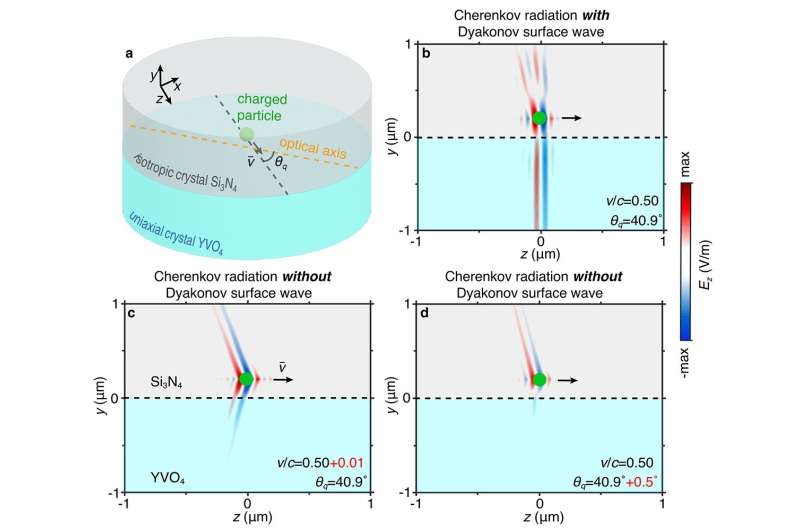Schematics of surface Dyakonov-Cherenkov radiation. b, Field pattern of Cherenkov radiation with Dyakonov surface waves. c-d, Field patterns of Cherenkov radiation without Dyakonov surface waves. Credit: Hao, Hu, Lin, Yu Luo
Recently, the research team led by Prof. Yu Luo from the school of Electrical and Electronic Engineering, Nanyang Technological University, discovered surface Dyakonov-Cherenkov radiation. This new type of Cherenkov radiation not only presages the next generation of miniaturized Cherenkov detectors, but also provides an indispensable route to detect particle trajectory. Moreover, this work offers a feasible route to excite Dyakonov surface waves, opening a new area of research in Dyakonov surface optics.
Cherenkov radiation refers to the photon emission from the swift charged particle moves with the velocity greater than the phase velocity of light in the surrounding materials. Ever since its experimental observation by a Soviet physicist P.A. Cherenkov in 1934, Cherenkov radiation has been widely explored and applied in many research fields ranging from cosmology and information, to medical and life sciences. Among all these applications, the detection of high-energy particles (i.e., identifying the type of detected particles from the direction of the photon emission) is the most important one. With the help of Cherenkov radiation, scientists discovered many elementary particles including anti-proton and J-particle. Owing to its impacts on both the fundamental research and practical applications, Cherenkov radiation and its related applications were awarded at least six Nobel Prizes in Physics (in 1958, 1959, 1988, 1995, 2002 and 2015, respectively).
Although Cherenkov detectors are widely used in the high-energy and particle physics, their bulky sizes hinder their applications to emerging research fields such as particle detection on chip. Thus, achieving miniaturized particle detectors could potentially broadens the applications of Cherenkov detection. Surface waves propagating at the interface of two different materials provide a possible solution towards this goal.
Generally speaking, there are two major branches of surface waves in nature: surface plasmons propagating along the metallodielectric interface; and Dyakonov surface waves propagating along the surface of a birefringent material.
Since the 1950s, surface plasmons have been widely applied to surface-enhanced Raman spectroscopy, surface-enhanced sensing, and surface-enhanced fluorescence, etc. Recently, surface plasmons were deployed to enhance Cherenkov radiation and achieve integrated Cherenkov light sources (Nature Photonics, (2017)). Nevertheless, the implementation of a miniaturized Cherenkov detector with surface plasmons is still challenging, mainly for two reasons: (1) The significant metallic dissipation hinders the detection of Cherenkov signals in the far field; (2) The strong chromatic dispersion of plasmons presents an inherent limit on the working bandwidth of the detector. On the contrary, Dyakonov surface waves can be excited in an all-dielectric platform with negligible dissipation loss and weak chromatic dispersion. Despite these advantages, applications of Dyakonov surface waves have been thus far quite limited due to the lack of an efficient excitation mechanism.
This research team led by Prof. Yu Luo from Nanyang Technological University has uncovered a new type of free-electron radiations, namely surface Dyakonov-Cherenkov radiation. It is achieved by exploring the interaction between the free charged particle and Dyakonov surface waves. Such a discovery not only facilitates the development of miniaturized Cherenkov detectors, but may also inspires future explorations of Dyakonov surface waves.
The research team investigated the emission behaviors of a swift charged particle moving atop the surface of a birefringent crystal. They found that when the particle velocity and trajectory fulfill a specific condition, the swift charged particle allows for efficient photon emission in terms of Dyakonov surface waves.
Surface Dyakonov-Cherenkov radiation is one of the best candidates for achieving miniaturized particle detectors on a chip. First, Dyakonov surface waves can significantly enhance the photon emission, offering a feasible route to reduce the interaction length of the swift charged particle and matter. Second, due to the negligible dissipation loss and weak chromatic dispersion of Dyakonov surface waves, the emitted photons can be readily collected in the far field.
Remarkably, the research team also found that the excitation of surface Dyakonov-Cherenkov radiation is highly sensitive to both the particle trajectory and velocity value. Only when the particle trajectory falls within the vicinity of a particular direction, the surface Dyakonov-Cherenkov radiation is allowed. Such a unique property results from the directional nature of Dyakonov surface waves. It allows the surface Dyakonov-Cherenkov radiation to detect the particle trajectory, with the accuracy up to 10 mrad.
The surface Dyakonov-Cherenkov radiation studied in this work also bridges the research gap between Cherenkov radiation and Dyakonov surface waves, and may produce far-reaching impacts on both areas. In the realm of Cherenkov radiation, this work not only facilitates the development of next-generation miniaturized Cherenkov detectors, but also offers a unique technique to track and collimate the particle beams, which is highly desired in nonlinear, ultrafast and quantum optics. In the realm of Dyakonov surface waves, the efficient excitation mechanism revealed in this work may open a new research area of Dyakonov surface optics.
More information: Hao Hu et al, Surface Dyakonov–Cherenkov radiation, eLight (2022). DOI: 10.1186/s43593-021-00009-5. elight.springeropen.com/articl … 6/s43593-021-00009-5
Mikhail Dyakonov, From Dyakonov-Cherenkov radiation to Dyakonov surface optics, Light: Science & Applications (2022). DOI: 10.1038/s41377-021-00692-6
Journal information: Nature Photonics , Light: Science & Applications
Provided by Chinese Academy of Sciences
























